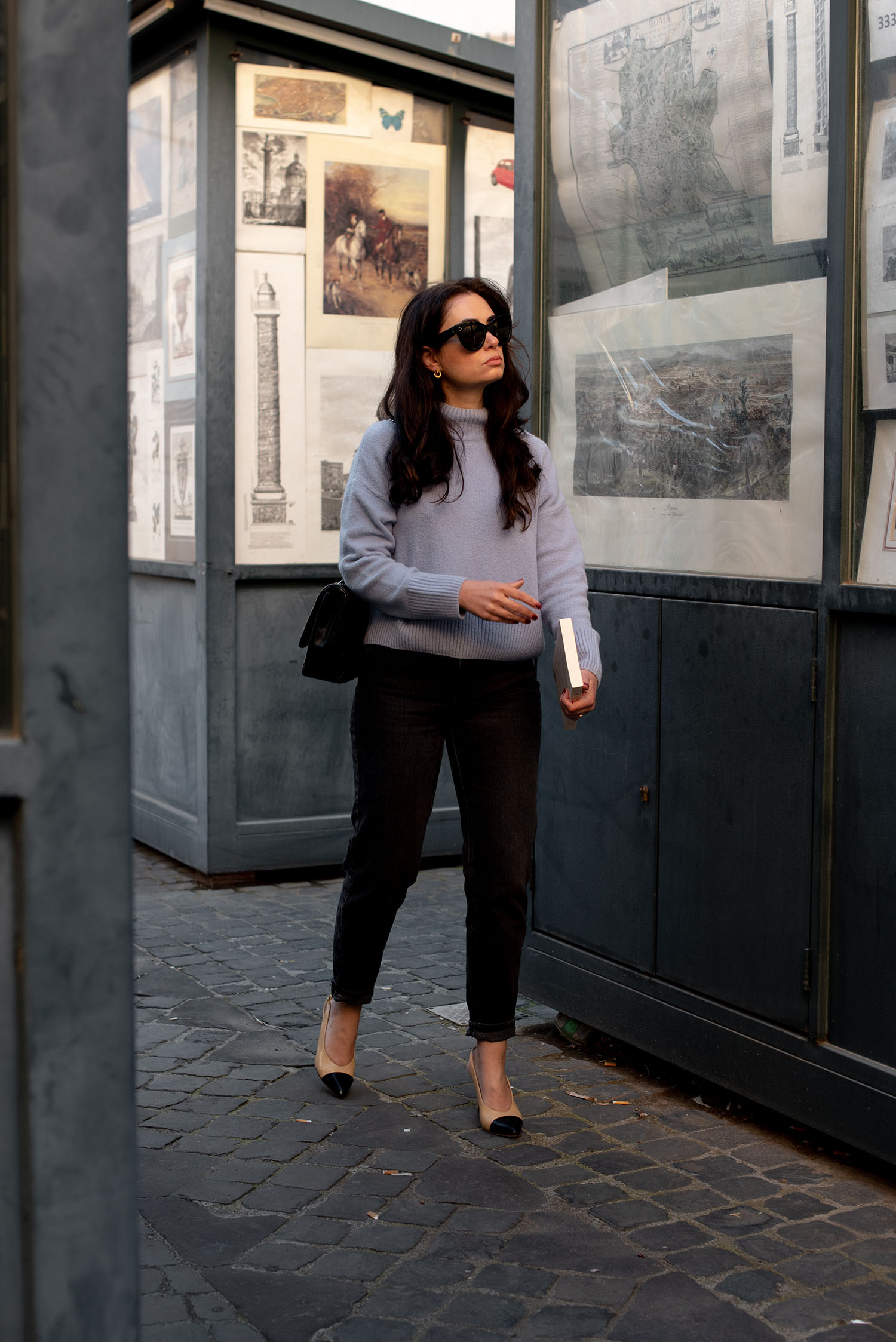
Zara jeans (similar)
Vintage Chanel heels (similar)
Chanel handbag
Celine sunglasses
Mejuri earrings (similar)
Location: Piazza Borghese – Rome, Italy
These photos, snapped at Piazza Borghese among the booksellers stalls on our last day in Rome this spring are pictures of me at thirty-six, but they could be pictures of me at almost any age. Pictured: a brunette, often wearing big sunglasses, carrying a book under one arm. (Evidence here, here and here.) Just as often, in real life, the book is a notebook. And there’s a pen in my purse, at the ready. I’ve been carrying those essentials around since my early adolescence. I’m older, because aging is an inescapable consequence of continuing to live, and different in some ways. But the same in so many others, despite the passage of time.
Lately, I’ve been thinking a lot about the ways we change and the ways in which we remain the same. About parallels and patterns; the way they manifest in our lives, and the way we subconsciously perpetuate them, sometimes without understanding their importance. And more often, without understanding that we’re doing it at all.
Since it’s mid-July, I’m not sure the goal is still realistic, but I’d hoped to publish my third book this year. This book marks both the end of the series and the end of an era for me. I started the first draft of my first novel on a Sunday evening when I was fifteen, I’m sure as a pretext to escape family dinner early. Then, much like now, I was bursting with ideas. I was perpetually propelled forward by the impetus to start something new but rarely motivated to finish anything. That book was no different. After two chapters and a single unfinished paragraph, I set it aside. It was only pressure from a close friend that made me pick it up again.
What started on an ordinary Sunday evening unexpectedly became the work of a lifetime. I’ve laboured over these three books. And ultimately felt brave enough to let two of them out into the world, perceived flaws, real flaws and all. Over the years, I’ve answered countless questions about them. That’s one of the strangest parts of being a writer… that arranging words on paper, the essential work of writing, is really just the beginning.
Like Joan Didion, I write mostly to understand what it is that I’m thinking, which makes attempts to subsequently explain my process an exercise in hilarity. I have no answers. I know less than readers can surmise by reading my work, I often suspect. But people want to know, and I understand why they would, so I try my best. When did you start these books, they ask, and why, and how on earth do know so much about guns? And, the question that invariably interests people the most, how much is your main character based on you? My standard answer, always paired with a short laugh, is, “Not at all, apart from the fact that she has brown hair.”
…looking back, I realise that answer is wrong. Not deliberately wrong, but wrong, anyway. I was telling people what I believed was the truth. Until I started looking closely, motivated by a desire to understand some of my own patterns so I can ultimately break them, I couldn’t see the striking parallels between her life and my own. When I look, I can see it wasn’t an accident that I started writing her story when I was fifteen. And that the events she’s navigated, albeit in an entirely different context and geography from mine, are not so different from events that I lived in my own past. Events that I’m still trying to make sense of decades later, when there was no sense to them at all… they were just things that happened.
The parallels between our emotions are more significant. Even in scenarios that in no way resemble anything in my own life, she feels what I would feel. I reread her story and watch, now baffled, as reacts in ways that I’ve reacted without understanding why, except that I couldn’t think of anything else.
At fifteen, I wasn’t just trying to escape from family dinner, although that was always a powerful motivator. I was a little bit less than a year out of my first relationship, which I remember mostly as a fraught and unhappy one. It came quite abruptly to its inevitable conclusion – but not so abruptly that he didn’t have time to find a new girlfriend before making the phone call to end it. The question I’d never dared to ask aloud reverberated in every fibre of my being because it remained unspoken: if he could move on from me so quickly, did I ever mean anything to him in the first place?
The girl in these photos, carrying a book, carries that question with her, too. She has for the past twenty years, in every photo where she carries a book. And every photo where she doesn’t. It makes its way into places she least expects, sometimes so subtly that she can’t see it, like a train-ride scene in her first novel. The parallels are there, if you know how to look for them. But why would you? A lot of the time, even I don’t. If I knew the answers to these questions – to borrow, again, from Joan Didion – there would be no reason to write.